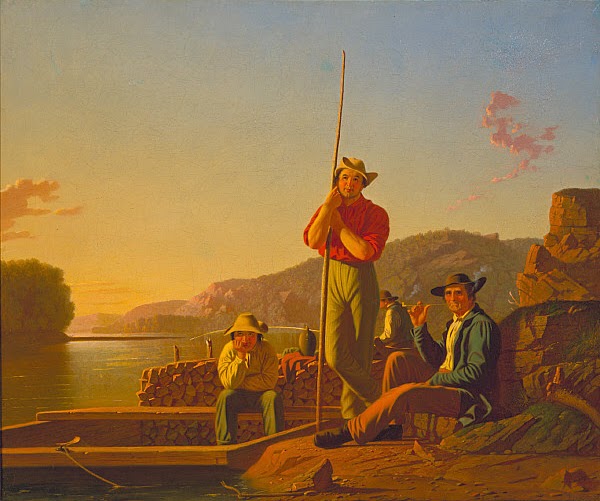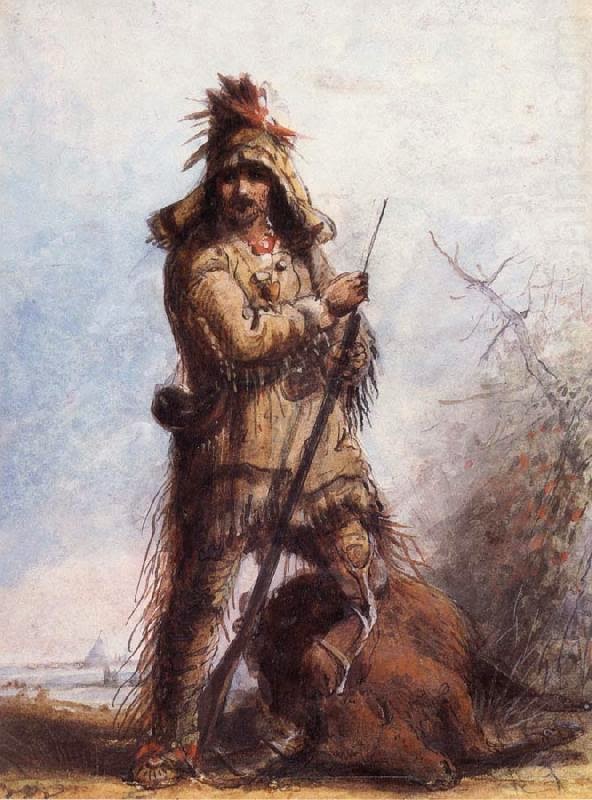More can be written about the American painter Thomas Cole than I could possibly wrap up in a single post, especially with my extremely limited knowledge of him and his work, but I do know some things worth sharing and hope they may lead you elsewhere for your own private elucidation.
Thomas Cole is considered the father of the Hudson River School of American painting. Cole is known for realistic (I would say hyperrealistic) representations of the American landscape and wilderness. Students of the Hudson River School are marked heavily by his hand and not a small dash of romanticism. This leads to a series of paintings from various artists that are instantly recognizable by their composition and execution as part of the school. Many people notice something familiar about Cole’s (and Hudson River School painters’) work without being totally aware of their connection or provenance.
 |
| Thomas Cole February 1, 1801-February 11, 1848 |
One of Cole’s most famous works is a series of five paintings that follow the rise and fall of a civilization. Called The Course of Empire, the series maintains a single cliff as a point of reference as time marches through the highs and lows of life. This has always been one of my favorite series for not only the depiction of a story line but also the process of geological time. The cliff, silent and steadfast watches empires rise and fall. Of course if the series was repainted today the cliff would be blasted away and a prairie would have to reclaim the parking lot that was left.
 |
| The Savage State |
The first in the series shows wilderness at its finest. The Savage State is in a state of savagery. A place ready for the conquering. The tepee and smoke on the right offset the mountain man on the left.
 |
| The Arcadian or Pastoral State |
What a difference a little working on the land makes. Settlers have cleared the land for pasture for their sheep, they are working the land for their own purposes wrestling it from the wilds off nature. Some dancing and boat-building round out the people in the scene. The striking inclusion of a monolithic temple harkens to the pre-super-civilization of the peaceful Grecians. To me it has always looked more like Stonehenge, but it is hard to ignore the Greco-Roman influence in the white marble superstructures of the remaining paintings in the series.
 |
| The Consummation of Empire |
Well, it just doesn’t get any better than this, right? The apex of civility. The statuary, the architecture, the fountains, the artwork, the people, it is all here. Throngs of people look on as ships fill the harbor. The lone cliff faces a man-made mountain of carved marble across the river. What is the worst that could happen.
 |
| Destruction |
A long way from the Indian camps on the banks of the river, the city has been sacked, raped and pillaged. Fantastic arched bridges have been destroyed, fire and death reign. One damsel flinging herself over the parapet to protect her honor. The headless warrior is enormous, and striking, even headless. Leading forward, its shield no use in protecting his city. The last time we looked at this in class it finally occurred to me who this *really* is. Thomas Cole, like most men in his position, and some other painters we have discussed here, were staunch anti-democrats–especially Jacksonian democracy. With Old Hickory being one of our military presidents, it is pretty obvious who Cole wanted to portray not only as a soldier, but a headless one ever charging forward. (That may not be the case, but Cole is pretty straightforward with his natural order of things when a fully democratic state is achieved in lieu of an educated elite controlling the republic (Whigs).
 |
| Desolation |
The last rays of the day illuminate what is left of the city on the hill. Ruins reclaimed by nature, on its way back to the savage state. Birds now nest on the towering ornately carved pillar, and the man-made marble mountain has lost its competition with nature’s cliff. No boats sail the harbor, there is nothing to trade, and no one to trade with. The end has arrived, nature slowly takes over. These, completed in 1836 after three years of working only added to the mystique of similar images that John Lloyd Stephens painted of the lost Mayan world in his Incidents of Travel series that ranged from 1837 to 1843.
Cole returned to this chrono-story painting in 1838 in his two part “The Past” and “The Present” paintings featuring a European castle in place of Greco-Roman white marble.
 |
| The Past |
A picturesque jousting tournament with a meadow filled with spectators, speeding chargers, tents, and various forms of ye olde faire merriment. Opulence and wealth cannot be overstated. I am not 100% convinced this isn’t a pseudo-next in the series above with the lookout tower in the background placed on the old cliff overlooking the river.
 |
| The Present |
More ruins, this time medieval and not ancient, but ruins nonetheless. While the scene has digressed, savagery has not fully returned. The shepherd is back, perhaps maintaining a herd on the same glade that the original Arcadian sheep grazed.
Regardless of whether they are a continuation of the Empire series or not, this tiny cross section of Thomas Cole’s work gives you some idea of the high romanticism that shaped the Hudson River School of painting. More than just representations of the real or political commentary, Cole weaves hyperrealism with political philosophy to literary paint a portrait of time’s endless march forward (and perhaps with at least some degree of cyclic change).

































